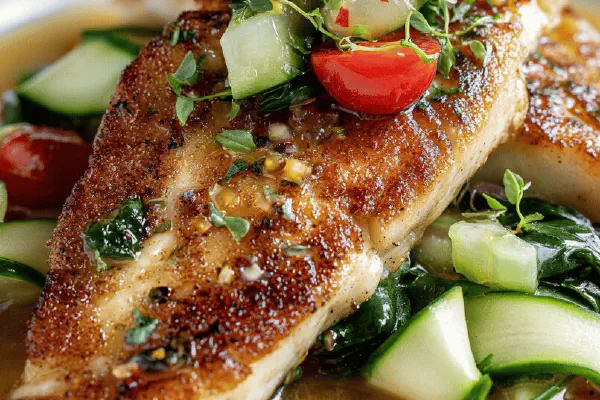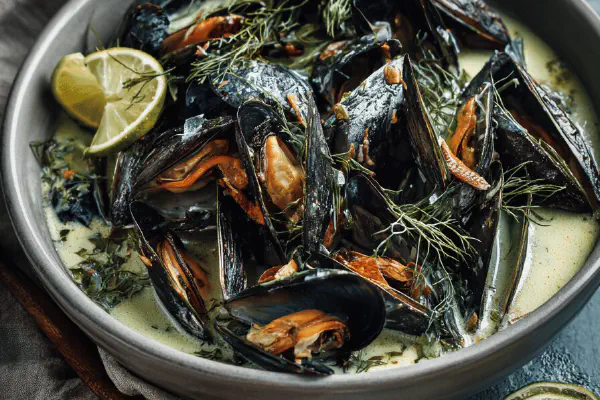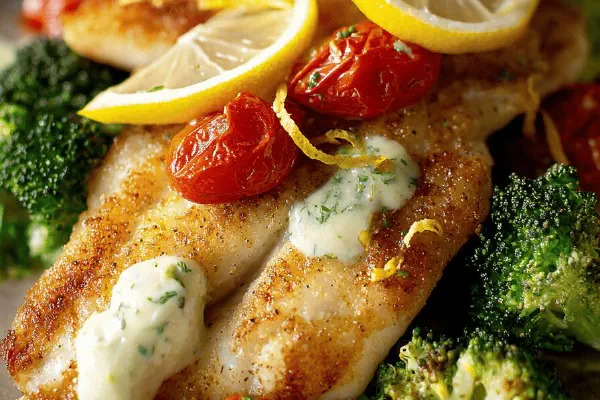Seared Tilapia with Warm Grapefruit Sauce

E
By Emma
Certified Culinary Professional
•
Recipe tested & approved
A quick pan-seared tilapia, served with a warm grapefruit vinaigrette featuring shallots and thyme instead of green onions and coriander. Slightly reduced honey for balanced sweetness. Includes a zesty twist with chopped mint for freshness and cucumber ribbons as an optional crisp side. Simple, bright flavors with no dairy, nuts, gluten, or eggs. Timing emphasized on visual cues and aromas, teaching when fish is done by texture and sauce by syrupy reduction. Practical tips on handling tilapia and making sauce without burning. Serve with new potatoes or roasted radishes for earthiness.
Prep:
25 min
Cook:
10 min
Total:
35 min
Servings:
4 servings
#fish
#seafood
#quick meals
#gluten free
#dairy free
#healthy
#seafood sauce
Started off always overcooking tilapia; it’s flaky but can dry out fast. Learned to watch edges crisp, translucent flesh turn to opaque, then time about 3 minutes each side. Honey is tricky—a small but potent sweet addition, changed original 15 ml to less, so it doesn’t overshadow grapefruit’s bright bitterness. Shallots instead of green onions give richer aromatic base and less vegetal sharpness. Added mint last minute after reduction, because herb notes fade with heat but add fresh burst if timed right. Warm vinaigrette sounds odd but it amplifies citrus notes and moistens dried-out fish, especially if you got distracted. Mache is mild, pairs well but baby spinach works too if you have it. I toss greens right before serving; wilting happens fast and ruins texture. Cucumbers optional but I appreciate texture contrast, especially when platter starts feeling mushy. Roasted radishes replaced potatoes once; earthy, slightly sweet and hold firm better. Splash of acid and sweetness, herbal punch, tender fish; all layers working.
Ingredients
- 600 g tilapia fillets (skin removed if preferred)
- 50 ml olive oil
- 2 shallots finely diced
- 1 clove garlic minced
- 10 ml honey
- 100 ml fresh ruby grapefruit juice
- Supremes of 1 large pink grapefruit
- 15 ml chopped fresh mint leaves
- 200 g mache or baby spinach
- Salt and black pepper
- Optional cucumber ribbons for texture
About the ingredients
Tilapia is inexpensive but slips and breaks easily. Pat dry—lots of moisture means no good sear. Olive oil with medium smoking point works here though avocado also fine. Honey—feel free to swap with maple syrup but acidity balance shifts, so reduce grapefruit slightly if using maple. Shallots can be replaced with mild onions but cut in smaller pieces to avoid harsh bite. Mint is wildcard but adds fresh counterpoint to sweet, tart sauce; if not available, basil or tarragon might play similarly but alter profile. Grapefruit juice frozen or fresh, fresh always wins—store-bought can be too sweet or watery, losing punch. Mâche sensitive to excess moisture; dry thoroughly or serve on napkins under. Cucumber ribbons add crunch and moisture contrast but slice thin to avoid dilution and sogginess on plate. Season with salt pepper carefully; citrus and honey can mask under seasoning. Salt early on fish but cautiously in sauce. Sometimes I add a pinch of smoked paprika or chili flakes to punch mild sauce but beware flames if oil hot.
Method
- Pat tilapia dry with paper towels. Heat olive oil in a heavy skillet over medium-high heat. Lay fish away from you in oil. Cook undisturbed until edges lift and flesh is opaque about 3 minutes per side depending on thickness. Fish should spring back when pressed gently. Season lightly with salt and pepper just before flipping. Remove fish and keep warm loosely tented in lowest oven setting.
- In the same pan (don’t rinse), reduce heat to medium-low. Add shallots and garlic. Stir often until softened and fragrant, about 2–3 minutes. Watch carefully to prevent browning which turns bitter.
- Drizzle honey over shallots, let bubble until it starts to turn amber, roughly 1 minute. Pour grapefruit juice in to deglaze—should hiss a little. Stir, let sauce reduce to about half its volume; watch for syrupy texture and nap the back of a spoon consistency. Add grapefruit supremes and chopped mint last. Season with salt and pepper to balance the tartness.
- Toss mache or spinach with a tiny bit of olive oil and a pinch of salt—serves as cooler fresh counterpoint.
- Plate fish on greens or alongside. Spoon warm vinaigrette over fillets. Add cucumber ribbons for crunch if using. Serve immediately.
- Optional sides: small roasted new potatoes or radishes provide earthy note and soak up sauce well.
Cooking tips
Heat control is everything. Tilapia cooks fast; listen for gentle sizzle—if roaring, oil’s too hot, risk burned exterior raw inside. No flipping multiple times; one side per stage. Press fish gently to check firmness; should give slightly but snap back. Don’t crowd pan, does nasty steam, no crisping. Keep cooked fish warm in lowest oven; foil tent keeps moisture without steaming. Sauce is next trick. Use same pan to catch all fond—flavor gold. Lower heat for shallots and garlic; golden not brown, else bitterness soured my first attempts. Honey melts fast; watch color change from pale to a light amber, then pour juice immediately to prevent burning. Juice will hiss and steam; don’t panic, that’s good. Reduce until sticky enough to coat spoon. Adding grapefruit supremes and mint last keeps them vibrant, fresh. Toss greens last to retain texture; wilt ruins plate appeal. Cucumbers sliced thin balance warm sauced fish with cool crispness. Serve immediately. No resting fish on plate or it gets soggy. Timing matters; make sauce during resting fish to minimize downtime. I usually prep sauce while fish cooks on second side, then rest fish briefly and toss greens quickly before plating. Efficiency plus flavor. Salt before fish hits pan to draw out moisture but don’t overdo; salt after for sauce, taste, adjust. Common mistake: sauce burns down too far, taste bitter or too thick—add splash water, stir, rescue instantly. Don’t skip deglazing step or sauce lacks depth. Don’t over reduce juice or dry out; aim for balance, viscous but pourable.
Chef's notes
- 💡 Pat fish dry completely. Moisture kills sear quality. Use paper towels, press gently but firm. Oil hot but not smoking. Lay fish away from you. Listen for gentle sizzle, not roar. One flip only, edges lift, flesh opaque. Press to check firmness, bounce back means done. Keeps fish intact, no falling apart.
- 💡 Honey melts fast and darkens quickly. Watch color carefully, pale amber signals ready. Drizzle then wait for bubble burst; no rush to pour juice so no burning. Juice causes hiss sound on deglaze. Stir often but gently to avoid scorching sugars. Sauce thickness cues come from syrupy nap coat on back of spoon—sticky but pourable.
- 💡 Shallots soften around 2 minutes, garlic cooks faster, so add together but watch for color change. Browned bits bitter—scrap and reset pan if burnt. Using mint added last keeps it bright. Heat kills fresh aroma so toss right before serving, flavor loss noticeable otherwise.
- 💡 Greens tossed at last minute preserve texture. Wilt happens fast with residual heat. Mâche delicate, dries fast so handle minimally, serve on napkins if needed. Spinach firmer alternative but same toss-in-strategy. Incorporated olive oil and salt underplay bitterness from grapefruit but don’t overdo salt early on fish or sauce becomes dull.
- 💡 If fish sticks, pan not hot enough or too wet fish. Add more oil, dry fish extra well. For sauce too thick or bitter, add splash cold water or fresh juice to rescue. No multiple flips, no crowding pan—steam ruins crisp edges. Rest fish loosely covered in low oven, keeps warm without sogginess. Timing sauce while fish rests saves time and flavor.
Common questions
How to know when tilapia is done?
Look for edges curling and flesh turning opaque; press gently, bounce-back means ready. Don’t go by time alone. Timing varies with thickness.
What if sauce burns or tastes bitter?
Happens if heat too high or honey browns too long. Lower heat fast, add splash water or juice to rescue. Start sauce again if burnt bits stuck.
Alternative herbs to mint?
Dill with lemon zest works well. Basil or tarragon ok but changes flavor profile. Add last minute to keep fresh notes. If none, omit rather than overcook herbs.
Can leftovers be stored?
Short fridge hold only. Reheat gently oven low or warm sauce in pan, add fish last. Microwave kills texture fast. Sauce thickens on cooling; add fresh juice if needed to loosen.



